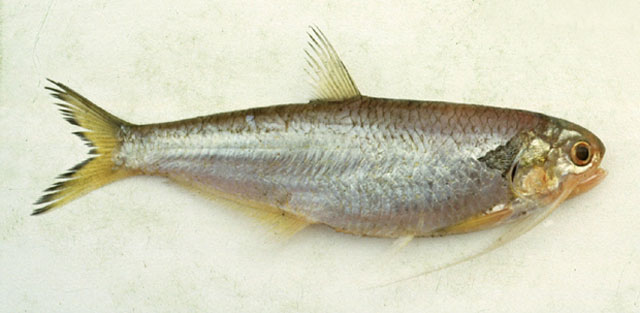| Engraulidae (Anchovies), subfamily: Coiliinae |
| 18 cm SL (male/unsexed) |
|
pelagic-neritic; brackish; marine; depth range 1 - 20 m |
| Indo-Pacific: India Ocean from Gulf of Oman south to Port Alfred, but no records from the Red Sea and Madagascar; coasts of Pakistan, India and probably Burma; Thailand, Indonesia, Philippines to Taiwan (Ref. 189), including Arafura Sea (Ref. 9819); also northern Australia, Papua New Guinea, Solomon Islands and New Hebrides (Ref. 189). |
|
Dorsal spines (total): 0-0; Dorsal soft rays (total): 14-16; Anal spines: 0-0; Anal soft rays: 32-39. Diagnosis: Body fairly compressed, belly with 16-18 plus 9-10, with a total of 25-28 keeled scutes; lower gill rakers 10-12; head with gold tints; anal and caudal fins deep yellow; a black area behind upper part of gill opening (Ref. 189). It is distinguished from all other Thryssa species and in fact all other anchovies by the very long maxilla, reaching at least to tip of pectoral fin, usually to pelvic fin base or even to anal fin origin; also unique is the high coronoid process of the lower jaw, the jaw rising steeply in the mouth (Ref. 189).
Description: Body fairly compressed (Ref. 189). Maxilla very long, reaching at least to tip of pectoral fin (Ref. 189, 2871, 30573). Lower gillrakers on first arch 10 to 12, upper gillrakers 6; branchiostegal rays 10 (Ref. 189, 5430, 30573). Dorsal fin with 3 unbranched and 11-13 branched rays; anal fin with 3 unbranched and 29-36 branched rays; pectoral fin with 1 unbranched and 11-13 branched rays; pelvic fin with 1 unbranched and 6-7 branched rays (Ref. 5430, 122607). Scales on the lateral line 41-46 (Ref. 5430). Scutes present before and behind the pelvic-fin base; 16-18 pre-pelvic scutes and 8-10 post-pelvic scutes (Ref. 189, 5430, 30573, 122607).
Colouration: Head with gold tints; anal and caudal fins deep yellow; a black area behind upper part of gill opening (Ref. 189). |
| Marine, pelagic, presumably schooling, occurring mostly close inshore, entering bays and estuaries (Ref. 189, 30573). Recorded at a temperature range of 26.0-29.0 °C in the Trinity Inlet system, Australia (Ref. 4959). It feeds mainly on crustaceans, like amphipods, zoea larvae, Acetes (Ref. 189, 30573). May be caught using ringnets (Ref. 5213). Used as bait in the tuna fishery in the South Pacific. |
|
Least Concern (LC); Date assessed: 06 March 2017 Ref. (130435)
|
| harmless |
Source and more info: www.fishbase.org. For personal, classroom, and other internal use only. Not for publication.

